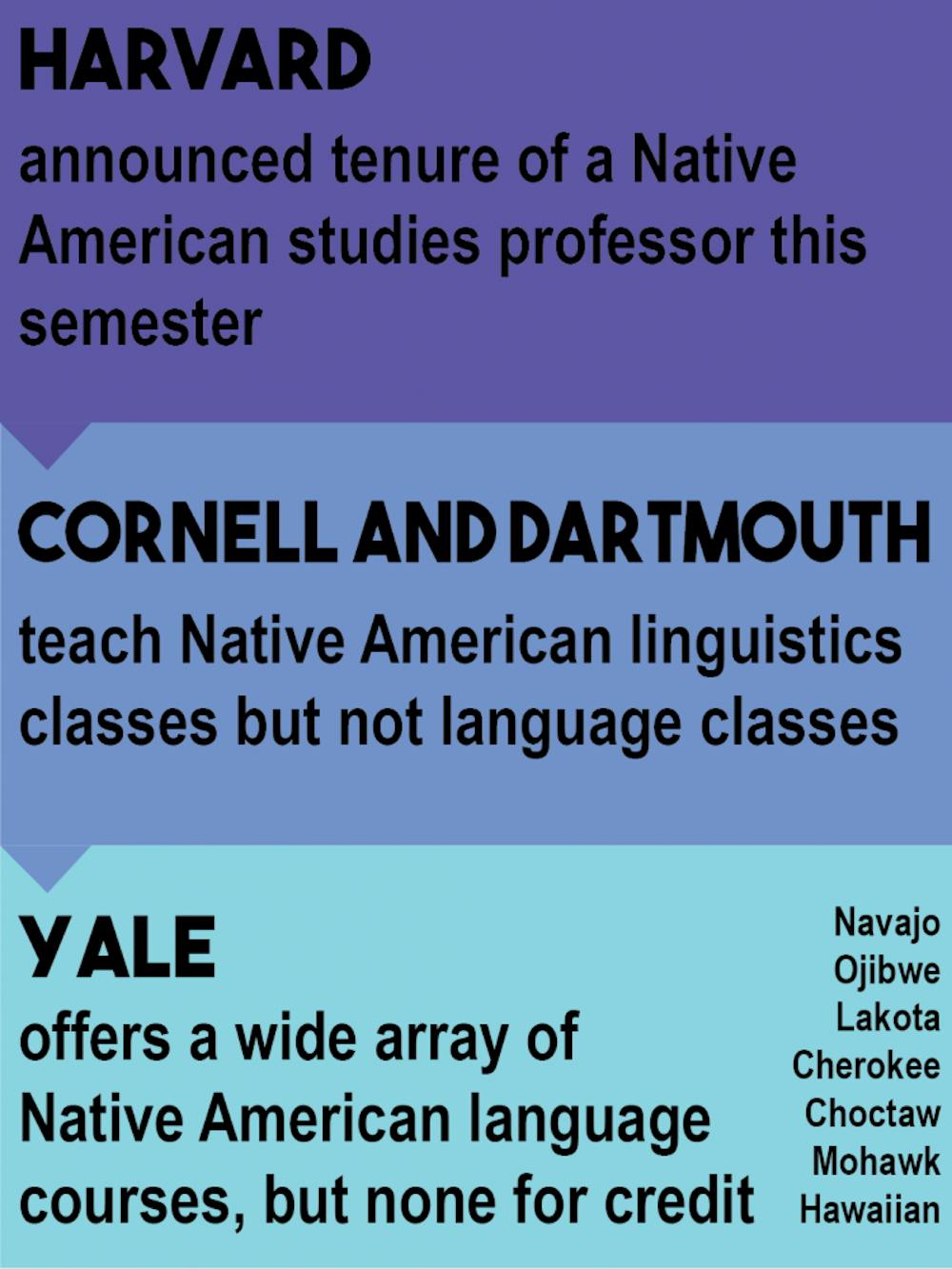
The Cherokee language, which may be offered at Penn starting in the fall 2018 semester, has a written syllabary that was developed in the 19th century // Public domain
While Penn does not currently offer a wide range of Native American language classes, the University may soon become the first institution in the Ivy League to offer course credit for undergraduate North American Native American language classes.
Penn currently offers Quechua, a language native to South American indigenous groups in the Andes. However, this class is not sustainable and cannot be offered for four semesters to fulfill the Penn Language requirement, according to Executive Director of Language Instruction Christina Frei.
But this past December, the Penn Language Center was awarded a level-two, two-year $74,622 Digital Humanities Advancement Grant from the National Endowment for the Humanities, which Frei said will go towards revitalizing and preserving native languages and cultures.
PLC met with the Price Lab at the University of Pennsylvania to establish a timeline for the grant, including an October 2018 meeting between the tribal groups involved in this project.
The Penn Language Center, separately from the grant, also plans to expand its native language offerings to include Cherokee. According to Frei, they already have recruited professor Tom Belt, coordinator of Western Carolina University's Cherokee Language Program.
It is possible, but unlikely, that Cherokee will be introduced in fall 2018.
"It's going to be a long term process; it's not something that can be done in the short term," Frei said.
Keturah Peters, a member of the Mashpee Wampanoag Tribe and a Nursing senior, said she would take a Cherokee language course if offered.
“For me, it sometimes feels like you come to these institutions that you are pushed to study what people consider to be most 'useful' here in the United States,” Peters said. “They do not emphasize how language can be empowering or a form of resistance.”
Wharton junior and Chickasaw Nation citizen Caleb Carter said that there are currently fewer than 75 speakers of Chikashshanompa, the native Chickasaw language. In light of this situation, the Chickasaw Nation has made pushes to make sure the language is not lost.
“My tribe has been making a big push lately to ensure the language isn’t lost, and so they’re offering a newly-developed free Rosetta Stone of the language to all Chickasaw citizens,” Carter said. “It would be such an amazing gesture of respect if Penn worked to help preserve Native American languages by finding ways for courses of study like this to count toward students’ language requirements.”
Among other Ivies, Yale is the only institution that offers a wide array of Native Language courses — Navajo, Ojibwe, Lakota, Cherokee, Choctaw, Mohawk, and Hawaiian — through its 2015 Native American Language Project (NALP). These classes are not offered for credit.
Yale sophomore Chase Warren, who takes two classes in the program, said that Yale and its peer institutions trail behind major institutions which offer indigenous language programs for credit, including Stanford University, University of Minnesota, and University of Wisconsin-Madison.
"I think it’s honestly a shame that the Ivies lack native-related education," Penn College freshman and member of the Lumbee tribe Connor Beard said. "By institutions like Yale not giving the language the same status as we would other [languages], the culture and language is being de-legitimized."

This semester, Harvard announced the tenure of a Native American studies Professor Philip J. Deloria. Other Ivies, such as Cornell and Dartmouth, teach Native American linguistics classes, but not language courses.
Penn also offers a Native American linguistics course through the Native American and Indigenous Studies Initiative (NAIS), a Penn program dedicated to the culture and history of native and indigenous populations in the Americas. The course is taught by Professor Gene Buckley and deals with the structure of language – sounds, word formations, and sentence structure – rather than vocabulary.
Despite the lack of current formal class offerings, Penn students theoretically have access to any indigenous language courses at the Penn Language Center, Frei said. The class would need to have a minimum of six students and the PLC would need to secure an instructor.
All courses offered through PLC count for credit.
"It is a mission of the Penn and the Penn Language Center to promote and preserve indigenous languages," Frei said. "The deans understand that diversity also includes indigenous communities, and often times these communities are left out when talking about diversity."
The NEH grant is just the beginning for indigenous language and culture revitalization at Penn, explained Frei.
"We are leading the pack," she said. "I think Penn can play a big role in achieving this goal."
As for what the future holds, Frei alluded to the potential of receiving a level-three NEH grant, which would give the PLC upwards of $300,000. A grant of that magnitude would help to sustain involvement with tribal pedagogy, and would help Penn discover how tribes are teaching their language and what kind of pedagogical tools they are using to do so.
"Coming from a tribe that revived their language, I see great importance in learning and using it to both keep it alive and honor my ancestors," Peters said. "For me, it is less about how I will utilize it but more about the fact that it is a huge part of my identity as a Mashpee Wampanoag individual.”
The Daily Pennsylvanian is an independent, student-run newspaper. Please consider making a donation to support the coverage that shapes the University. Your generosity ensures a future of strong journalism at Penn.
Donate




